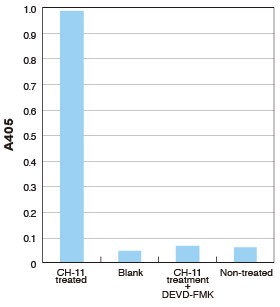Caspases
Apoptosis is primarily induced by the activation of caspases. Active caspases recognize a large number of different substrates, leading to the activation of several different apoptotic pathways. The cleavage of several structural proteins by caspases leads to the unique apoptosis cell morphology of chromatin condensation, nuclear fragmentation and cytoplasmic integrity. The most common method to measure caspase activity is via fluorometric or colorimetric detection of the cleavage of caspase-specific substrates.

Measurement of Caspase-3 activity using APOPCYTO™ Caspase-3 Colorimetric Assay Kit (Code No. 4800)
Cell: Jurkat
Caspase-3 activator: anti-Fas/CD95 (clone CH-11)
Caspase-3 inhibitor: DEVD-FMK
Learn more about other popular Apoptosis targets and products
GENERAL APOPTOTIC PRODUCTS
MBL International offers over 600 products including proteins, antibodies and kits to aid in the study of the apoptotic pathway. These products cover a wide variety of applications.
DNA FRAGMENTATION DETECTION
The TdT-mediated dUTP-biotin nick end labeling method (TUNEL method) enables in situ visualization of DNA fragmentation at the single cell level by labeling the terminal ends of nucleic acids. The MEBSTAIN Apoptosis Kit Direct is an apoptosis detection kit based on the TUNEL method.
CASPASE ACTIVITY ASSAY
Apoptosis is primarily induced by the activation of caspases. Active caspases recognize a large number of different substrates, leading to the activation of several different apoptotic pathways.
APOPTOSIS MAIN PAGE
Apoptosis, a form of programmed cell death, is not only a major process within normal homeostasis but is present in disease states such as cancer and many autoimmune and neurodegenerative diseases.